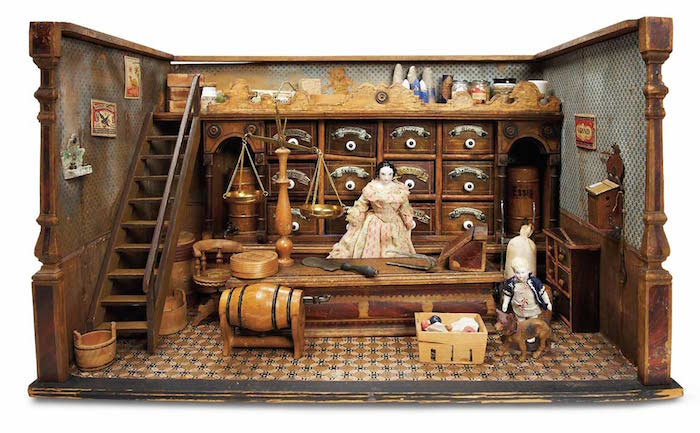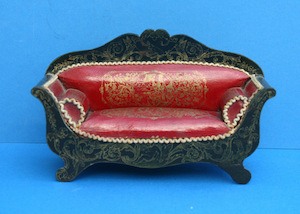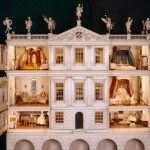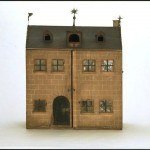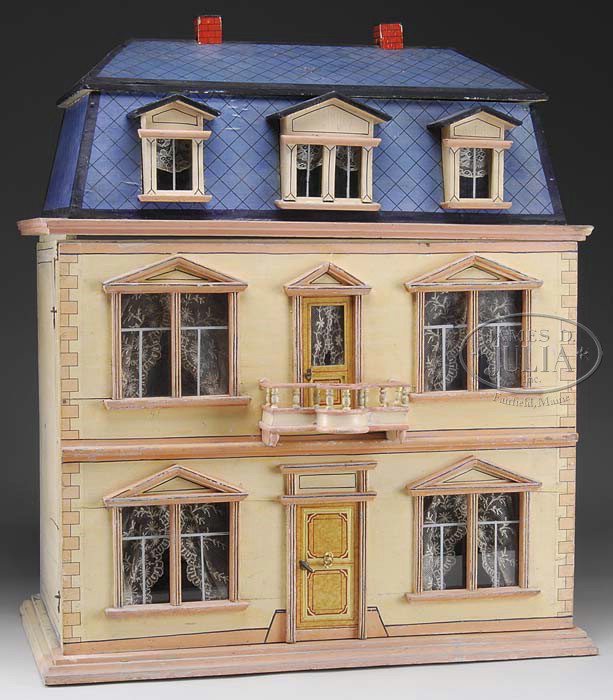
Charles Hacker Blue Mansard Roof Dollhouse found on James Julia Auctioneers
Christian Hacker Dollhouses
The Christian Hacker factory was founded in Nuremberg in 1835. Over the years it produced varieties of wooden toys such as dollhouses, miniature room boxes, toy stables, guard houses, kitchens, shops, castles, cars, trains and many others. The toys were very high quality and expensive. The company twice won medals in Paris at the Great Exhibition. The company closed in 1927 after the collapse of the German economy
Baroque Mansion Dollhouse
The mansard roof style of dollhouses was a popular Charles Hacker line. The Mini Time Machine history gallery offers this description:
“Christian Hacker produced elegant dollhouses, kitchens, and shops from the mid-1800s through 1914. The Nuremberg company is best known for its three-story dollhouses with mansard roofs although they produced houses in many styles including a series with hipped roofs. Because the houses had a French appearance, they were originally misattributed as made in France but one house was discovered in the 1970s with the inscription “Christian Hacker, Nuremberg, Germany, 1875, makers of wooden playthings.” The house was also stamped with a crown-topped shield that contained the initials “CH” below the word “shutzmarke” (German for “trademark.”)
“Most Hacker dollhouses were large in scale and impressive; ranging from two to four stories tall, with three to as many as eight rooms. The mansard roofs were designed to be stackable, each level roof included to be resting on the one below. The front walls of each section usually opened separately.”
Room Boxes
Miniature rooms were also favorite items at Charles Hacker. The auction site Theriault’s has an excellent description of a miniature grocery store, seen on the right below:
“A one-room wooden store with fancy columns at each side front has a staircase with railing, fitted back wall with twelve labeled spice drawers centered by arched display niches,, wood wainscoting, and original wall and floor papers. There is the original free-standing counter with wonderful detail of shapes and faux-rosewood finish that matches the faux-rosewood panels on the front columns. The store is fitted with an early scale, cabinet, wall telephone, barrel and frame, tin oil containers and various other foods and supplies. Two dollhouse people are in the store which measures 13″ (33 cm.) h. x 21 “1 x 11″d. Original throughout, although with wear, spotting and fading to finishes. Germany, Christian Hacker, the store is labeled 64/3 Made in Germany on the underside, circa 1880. A rare petite model, ex-collection Landsberg Doll House Museum.”
Furniture
Many styles of furniture are appropriate for Charles Hacker dollhouses. Baroque if your taste goes to the elaborate; Biedermeier if you are in a more utilitarian mood. German art deco style also works. Add a few Boulle pieces, if gold painted designs on leather appeals to you. Research such dollhouse furniture manufacturers as Eppendorfer & Nacke, Kestner and Schneegas for inspiration.
German Dollhouses
Germany produced many prized dollhouses until World War I signaled the beginning of the end. Notable miniature companies besides Charles Hacker included Gottschalk, Märklin, Rock and Graner and others. Their products were not only avidly collected in Central Europe, but regularly exported to Britain and North America. Germany’s involvement in WWI ended the export market and disrupted production. New manufacturers in other countries filled the void.
Susan Downing, with Patrick Owens


